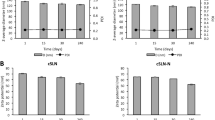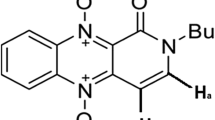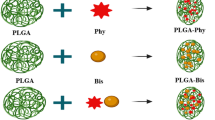Abstract
The phosphoinositide-3-kinases (PI3Ks) are a conserved family of lipid kinases that phosphorylate the 3-hydroxyl group of phosphatidylinositols in response to extracellular stimuli. PI3K pathway is enrolled in different kinds of human cancer and plays a prominent role in cancer cell growth and survival. Several PI3K inhibitors have been recently identified but some PI3K inhibitors with high potency in vitro do not show satisfactory effects in animal cancer models because of the poor pharmaceutical properties in vivo such as poor solubility, instability, and fast plasma clearance rate. In this study, we developed a sustained release system of PI3K inhibitor (TGX221) based on polyhydroxyalkanoate nanoparticles (NP) and used it to block proliferation of cancer cell lines. TGX221 was gradually released from PHA-based NP and growth of cancer cell lines was significantly slower in NP-TGX221-treated cells than in either negative controls or in cells receiving free TGX221. Since poor bioavailability and limited in vivo half-life are common features of hydrophobic PI3K inhibitors, our results open the way to similar formulation of other PI3K blockers and to new strategies in cancer treatment.






Similar content being viewed by others
References
Bader AG, Kang SY, Zhao L, Vogt PK (2005) Oncogenic pi3k deregulates transcription and translation. Nat Rev Cancer 5(12):921–929. doi:10.1038/nrc1753
Chaussade C, Rewcastle GW, Kendall JD, Denny WA, Cho K, Gronning LM, Chong ML, Anagnostou SH, Jackson SP, Daniele N, Shepherd PR (2007) Evidence for functional redundancy of class ia pi3k isoforms in insulin signalling. Biochem J 404:449–458. doi:10.1042/bj20070003
Cheng S, Wu Q, Yang F, Xu M, Leski M, Chen GQ (2005) Influence of dl-beta-hydroxybutyric acid on cell proliferation and calcium influx. Biomacromolecules 6(2):593–597. doi:10.1021/bm049465y
Cheng S, Chen GQ, Leski M, Zou B, Wang Y, Wu Q (2006) The effect of d, l-beta-hydroxybutyric acid on cell death and proliferation in l929 cells. Biomaterials 27(20):3758–3765. doi:10.1016/j.biomaterials.2006.02.046
Chin L, Meyerson M, Aldape K, Bigner D, Mikkelsen T, VandenBerg S, Kahn A, Penny R, Ferguson ML, Gerhard DS, Getz G, Brennan C, Taylor BS, Winckler W, Park P, Ladanyi M, Hoadley KA, Verhaak RGW, Hayes DN, Spellman PT, Absher D, Weir BA, Ding L, Wheeler D, Lawrence MS, Cibulskis K, Mardis E, Zhang JH, Wilson RK, Donehower L, Wheeler DA, Purdom E, Wallis J, Laird PW, Herman JG, Schuebel KE, Weisenberger DJ, Baylin SB, Schultz N, Yao J, Wiedemeyer R, Weinstein J, Sander C, Gibbs RA, Gray J, Kucherlapati R, Lander ES, Myers RM, Perou CM, McLendon R, Friedman A, Van Meir EG, Brat DJ, Mastrogianakis GM, Olson JJ, Lehman N, Yung WKA, Bogler O, Berger M, Prados M, Muzny D, Morgan M, Scherer S, Sabo A, Nazareth L, Lewis L, Hall O, Zhu YM, Ren YR, Alvi O, Yao JQ, Hawes A, Jhangiani S, Fowler G, San Lucas A, Kovar C, Cree A, Dinh H, Santibanez J, Joshi V, Gonzalez-Garay ML, Miller CA, Milosavljevic A, Sougnez C, Fennell T, Mahan S, Wilkinson J, Ziaugra L, Onofrio R, Bloom T, Nicol R, Ardlie K, Baldwin J, Gabriel S, Fulton RS, McLellan MD, Larson DE, Shi XQ, Abbott R, Fulton L, Chen K, Koboldt DC, Wendl MC, Meyer R, Tang YZ, Lin L, Osborne JR, Dunford-Shore BH, Miner TL, Delehaunty K, Markovic C, Swift G, Courtney W, Pohl C, Abbott S, Hawkins A, Leong S, Haipek C, Schmidt H, Wiechert M, Vickery T, Scott S, Dooling DJ, Chinwalla A, Weinstock GM, O'Kelly M, Robinson J, Alexe G, Beroukhim R, Carter S, Chiang D, Gould J, Gupta S, Korn J, Mermel C, Mesirov J, Monti S, Nguyen H, Parkin M, Reich M, Stransky N, Garraway L, Golub T, Protopopov A, Perna I, Aronson S, Sathiamoorthy N, Ren G, Kim H, Kong SK, Xiao YH, Kohane IS, Seidman J, Cope L, Pan F, Van Den Berg D, Van Neste L, Yi JM, Li JZ, Southwick A, Brady S, Aggarwal A, Chung T, Sherlock G, Brooks JD, Jakkula LR, Lapuk AV, Marr H, Dorton S, Choi YG, Han J, Ray A, Wang V, Durinck S, Robinson M, Wang NJ, Vranizan K, Peng V, Van Name E, Fontenay GV, Ngai J, Conboy JG, Parvin B, Feiler HS, Speed TP, Socci ND, Olshen A, Lash A, Reva B, Antipin Y, Stukalov A, Gross B, Cerami E, Wang WQ, Qin LX, Seshan VE, Villafania L, Cavatore M, Borsu L, Viale A, Gerald W, Topal MD, Qi Y, Balu S, Shi Y, Wu G, Bittner M, Shelton T, Lenkiewicz E, Morris S, Beasley D, Sanders S, Sfeir R, Chen J, Nassau D, Feng L, Hickey E, Schaefer C, Madhavan S, Buetow K, Barker A, Vockley J, Compton C, Vaught J, Fielding P, Collins F, Good P, Guyer M, Ozenberger B, Peterson J, Thomson E, Cancer Genome Atlas Research Network (2008) Comprehensive genomic characterization defines human glioblastoma genes and core pathways. Nature 455(7216):1061–1068. doi:10.1038/nature07385
Ciraolo E, Iezzi M, Marone R, Marengo S, Curcio C, Costa C, Azzolino O, Gonella C, Rubinetto C, Wu HY, Dastru W, Martin EL, Silengo L, Altruda F, Turco E, Lanzetti L, Musiani P, Ruckle T, Rommel C, Backer JM, Forni G, Wymann MP, Hirsch E (2008) Phosphoinositide 3-kinase p110 beta activity: key role in metabolism and mammary gland cancer but not development. Sci Signal 1(36). doi:10.1126/scisignal.1161577
Gursel I, Korkusuz F, Turesin F, Alaeddinoglu NG, Hasirci V (2001) In vivo application of biodegradable controlled antibiotic release systems for the treatment of implant-related osteomyelitis. Biomaterials 22(1):73–80
Jackson SP, Schoenwaelder SM, Goncalves I, Nesbitt WS, Yap CL, Wright CE, Kenche V, Anderson KE, Dopheide SM, Yuan YP, Sturgeon SA, Prabaharan H, Thompson PE, Smith GD, Shepherd PR, Daniele N, Kulkarni S, Abbott B, Saylik D, Jones C, Lu L, Giuliano S, Hughan SC, Angus JA, Robertson AD, Salem HH (2005) Pi 3-kinase p110 beta: a new target for antithrombotic therapy. Nat Med 11(5):507–514. doi:10.1038/nm1232
Jeong I, Kim BS, Lee H, Lee KM, Shim I, Kang SK, Yin CS, Hahm DH (2009) Prolonged analgesic effect of PLGA-encapsulated bee venom on formalin-induced pain in rats. Int J Pharm 380(1–2):62–66. doi:10.1016/j.ijpharm.2009.06.034
Ji Y, Li XT, Chen GQ (2008) Interactions between a poly(3-hydroxybutyrate-co-3-hydroxyvalerate-co-3-hydroxyhexanoate) terpolyester and human keratinocytes. Biomaterials 29(28):3807–3814. doi:10.1016/j.biomaterials.2008.06.008
Keniry M, Parsons R (2008) The role of pten signaling perturbations in cancer and in targeted therapy. Oncogene 27(41):5477–5485. doi:10.1038/onc.2008.248
Koosha F, Muller RH, Davis SS (1989) Polyhydroxybutyrate as a drug carrier. Crit Rev Ther Drug Carr Syst 6(2):117–130
Kueng W, Silber E, Eppenberger U (1989) Quantification of cells cultured on 96-well plates. Anal Biochem 182(1):16–19
Langer R (1998) Drug delivery and targeting. Nature 392(6679):5–10
Leevers SJ, Vanhaesebroeck B, Waterfield MD (1999) Signalling through phosphoinositide 3-kinases: the lipids take centre stage. Curr Opin Cell Biol 11(2):219–225
Li Q, Wang Y, Feng NP, Fan ZZ, Sun J, Nan YL (2008) Novel polymeric nanoparticles containing tanshinone IIa for the treatment of hepatoma. J Drug Target 16(10):725–732. doi:10.1080/10611860802374303
Liu Q, Chen GQ (2008) In vitro biocompatibility and degradation of terpolyester 3hb-co-4hb-co-3hhx, consisting of 3-hydroxybutyrate, 4-hydroxybutyrate and 3-hydroxyhexanoate. J Biomater Sci Polym Ed 19(11):1521–1533
Liu PX, Cheng HL, Roberts TM, Zhao JJ (2009) Targeting the phosphoinositide 3-kinase pathway in cancer. Nat Rev Drug Discov 8(8):627–644. doi:10.1038/nrd2926
Lu XY, Zhang YL, Wang L (2010) Preparation and in vitro drug-release behavior of 5-fluorouracil-loaded poly(hydroxybutyrate-co-hydroxyhexanoate) nanoparticles and microparticles. J Appl Polym Sci 116(5):2944–2950. doi:10.1002/app.31806
Muller RH, Maassen S, Weyhers H, Specht F, Lucks JS (1996) Cytotoxicity of magnetite-loaded polylactide, polylactide/glycolide particles and solid lipid nanoparticles. Int J Pharm 138(1):85–94
Mundargi RC, Babu VR, Rangaswamy V, Patel P, Aminabhavi TM (2008) Nano/micro technologies for delivering macromolecular therapeutics using poly(d, l-lactide-co-glycolide) and its derivatives. J Control Release 125(3):193–209. doi:10.1016/j.jconrel.2007.09.013
Parsons DW, Jones S, Zhang XS, Lin JCH, Leary RJ, Angenendt P, Mankoo P, Carter H, Siu IM, Gallia GL, Olivi A, McLendon R, Rasheed BA, Keir S, Nikolskaya T, Nikolsky Y, Busam DA, Tekleab H, Diaz LA, Hartigan J, Smith DR, Strausberg RL, Marie SKN, Shinjo SMO, Yan H, Riggins GJ, Bigner DD, Karchin R, Papadopoulos N, Parmigiani G, Vogelstein B, Velculescu VE, Kinzler KW (2008) An integrated genomic analysis of human glioblastoma multiforme. Science 321(5897):1807–1812. doi:10.1126/science.1164382
Perez C, Sanchez A, Putnam D, Ting D, Langer R, Alonso MJ (2001) Poly(lactic acid)-poly(ethylene glycol) nanoparticles as new carriers for the delivery of plasmid DNA. J Control Release 75(1–2):211–224
Rossi S, Azghani AO, Omri A (2004) Antimicrobial efficacy of a new antibiotic-loaded poly(hydroxybutyric-co-hydroxyvaleric acid) controlled release system. J Antimicrob Chemother 54(6):1013–1018. doi:10.1093/jac/dkh477
Saad B, Ciardelli G, Matter S, Welti M, Uhlschmid GK, Neuenschwander P, Suter UW (1996a) Cell response of cultured macrophages, fibroblasts, and co-cultures of Kupffer cells and hepatocytes to particles of short-chain poly (r)-3-hydroxybutyric acid. J Mater Sci Mater Med 7(1):56–61
Saad B, Ciardelli G, Matter S, Welti M, Uhlschmid GK, Neuenschwander P, Suter UW (1996b) Characterization of the cell response of cultured macrophages and fibroblasts to particles of short-chain poly (r)-3-hydroxybutyric acid. J Biomed Mater Res 30(4):429–439
Shi JJ, Votruba AR, Farokhzad OC, Langer R (2010) Nanotechnology in drug delivery and tissue engineering: from discovery to applications. Nano Lett 10(9):3223–3230. doi:10.1021/nl102184c
Steinbuchel A (2001) Perspectives for biotechnological production and utilization of biopolymers: metabolic engineering of polyhydroxyalkanoate biosynthesis pathways as a successful example. Macromol Biosci 1(1):1–24
Sun J, Dai ZW, Zhao Y, Chen GQ (2007) In vitro effect of oligo-hydroxyalkanoates on the growth of mouse fibroblast cell line l929. Biomaterials 28(27):3896–3903. doi:10.1016/j.biomaterials.2007.05.011
Thomas RK, Baker AC, DeBiasi RM, Winckler W, LaFramboise T, Lin WM, Wang M, Feng W, Zander T, MacConnaill LE, Lee JC, Nicoletti R, Hatton C, Goyette M, Girard L, Majmudar K, Ziaugra L, Wong KK, Gabriel S, Beroukhim R, Peyton M, Barretina J, Dutt A, Emery C, Greulich H, Shah K, Sasaki H, Gazdar A, Minna J, Armstrong SA, Mellinghoff IK, Hodi FS, Dranoff G, Mischel PS, Cloughesy TF, Nelson SF, Liau LM, Mertz K, Rubin MA, Moch H, Loda M, Catalona W, Fletcher J, Signoretti S, Kaye F, Anderson KC, Demetri GD, Dummer R, Wagner S, Herlyn M, Sellers WR, Meyerson M, Garraway LA (2007) High-throughput oncogene mutation profiling in human cancer. Nat Genet 39:347–351. doi:10.1038/ng1975
Vanhaesebroeck B, Leevers SJ, Panayotou G, Waterfield MD (1997) Phosphoinositide 3-kinases: a conserved family of signal transducers. Trends Biochem Sci 22(7):267–272
Wang ZX, Itoh Y, Hosaka Y, Kobayashi I, Nakano Y, Maeda I, Umeda F, Yamakawa J, Kawase M, Yagi K (2003) Novel transdermal drug delivery system with polyhydroxyalkanoate and starburst polyamidoamine dendrimer. J Biosci Bioeng 95(5):541–543
Wee S, Wiederschain D, Maira SM, Loo A, Miller C, DeBeaumont R, Stegmeier F, Yao YM, Lengauer C (2008) PTEN-deficient cancers depend on PIK3CB. Proc Natl Acad Sci USA 105(35):13057–13062. doi:10.1073/pnas.0802655105
Wu Q, Wang Y, Chen GQ (2009) Medical application of microbial biopolyesters polyhydroxyalkanoates. Artif Cells Blood Substit Immobil Biotechnol 37(1):1–12. doi:10.1080/10731190802664429
Xiao XQ, Zhao Y, Chen GQ (2007) The effect of 3-hydroxybutyrate and its derivatives on the growth of glial cells. Biomaterials 28(25):3608–3616. doi:10.1016/j.biomaterials.2007.04.046
Xiong YC, Yao YC, Zhan XY, Chen GQ (2010) Application of polyhydroxyalkanoates nanoparticles as intracellular sustained drug-release vectors. J Biomater Sci Polym Ed 21(1):127–140. doi:10.1163/156856209x410283
Yao YC, Zhan XY, Zhang J, Zou XH, Wang ZH, Xiong YC, Chen J, Chen GQ (2008) A specific drug targeting system based on polyhydroxyalkanoate granule binding protein phap fused with targeted cell ligands. Biomaterials 29(36):4823–4830. doi:10.1016/j.biomaterials.2008.09.008
Acknowledgments
This work was supported by grants from the National Natural Science Foundation of China (30801059), the Doctoral Fund of Ministry of Education of China (200806981053), and AIRC, Regione Piemonte, Cariplo.
Author information
Authors and Affiliations
Corresponding author
Rights and permissions
About this article
Cite this article
Lu, XY., Ciraolo, E., Stefenia, R. et al. Sustained release of PI3K inhibitor from PHA nanoparticles and in vitro growth inhibition of cancer cell lines. Appl Microbiol Biotechnol 89, 1423–1433 (2011). https://doi.org/10.1007/s00253-011-3101-1
Received:
Revised:
Accepted:
Published:
Issue Date:
DOI: https://doi.org/10.1007/s00253-011-3101-1




